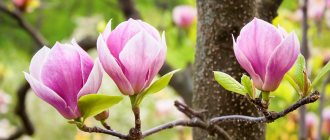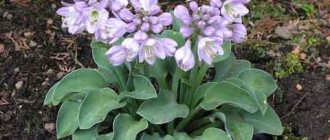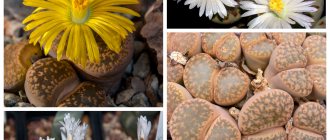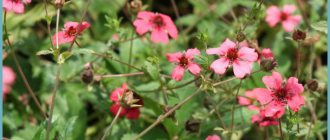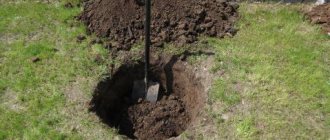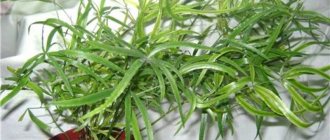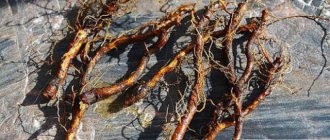Collecting seeds
Seeds in the Moscow region ripen by autumn, the cones open later. It is better to complete the collection of seeds before they begin to fall out of the cones. For propagation, we select only fresh cones with tightly pressed scales, under which the seeds are hidden. We don't need old cones. But how can you tell which cones on a branch are new and which are old and empty? First of all, they are easy to distinguish by their shape. In addition, the cones gradually darken.
This is what last year's larch cones look like
We put the collected cones in a cardboard box and leave them in a warm place for several days. There the cones will dry out, their covering scales will spread out. It is easier to get seeds from cones with bent scales.
We wrap the collected seeds in paper, sign it and store it until sowing or stratification.
Harvesting
Oooh, this is a whole art - extracting seeds from cones! They usually hang low, so you don’t have to use a stepladder. They need to be collected in November - if earlier, they may still be immature.
What if there are both new cones hanging on the tree and those left over from last season? How to distinguish them? New buds are lighter in color, and if you peel back the “scales” slightly, the seeds will be visible. As a rule, they have already flown out of the old ones. If you have Siberian or Japanese larch, collect the cones and place them in a linen bag on the radiator. The scales will bend back and you can get the seeds without any problems.
The cones of European larch open poorly, so each of them is cut along the axis with pruning shears, and then, breaking off the scales, the seeds are “released.” In both cases, collected seeds must be stored in a paper bag.
That’s all I’ve learned about larches, all that remains is to put the knowledge into practice. If you grow larch and have any advice, I would appreciate it)
Larch varieties
The most common types of larch are:
Tamarack
The height of the plant is from 13 to 32 meters, the diameter of the trunk is 50 cm. The crown is cone-shaped, the needles are 1-3 cm long. Cones in the form of rose buds are 2 cm in size.
Arkhangelsk larch
Plant height up to 40 meters, diameter - 1.5 meters. The variety has several features:
- the trunk thickens towards the base;
- the branches are raised upward and light yellow in color;
- brown cones with orange fibers;
- The wood is durable and resistant to rot.
Gmelin larch
This species easily tolerates frost and temperature changes. Trunk height 30 cm, width 80 cm. The bark is dense, the crown is oval. The cones look like a rose flower.
European larch
Plant height is from 20 to 5 cm, width from 80 cm to 1.5 meters. The branches are sagging, the needles are light green in color. Popular varieties:
- crying;
- creeping;
- compact;
- corley.
Crescent shaped cones.
Western larch
Height from 35 to 80 meters, diameter from 90 to 240 cm. The shoots are short and the crown shape is pyramidal. The cones are oblong, brown-red. The needles are light green.
Home care
In order for the plant to grow and develop well, it requires proper care, which consists of the following measures:
- Lighting for the first 90 days should be diffused; the plant should not be exposed to direct sunlight. The most suitable place for placing containers with seedlings is a windowsill on the east or west side.
- The temperature in the room where larch grows should be 19-20 degrees. In summer, the plant is protected from scorching sun rays, and for wintering the plant is placed on a glassed-in loggia.
- Watering is carried out when the top layer of soil dries. The plant cannot be flooded; excessive moisture in the soil will lead to the death of the seedlings. Larch responds favorably to spraying the crown.
- Loosening is performed after each watering to prevent stagnation of moisture in the soil.
- Fertilizing is applied as soon as young needles begin to appear on the plant. For these purposes, nitrogen-containing fertilizers are used. They will contribute to the active growth of green mass. In summer, the plant is fed with complex mineral fertilizers for conifers.
Sowing larch seeds
Selection and disinfection . Before sowing, you need to check the seeds for germination, because they are often empty. Empty seeds do not sink in a vessel with water, but full-grained ones sink to the bottom. Therefore, in order to sort larch seeds, we leave them in water for a couple of days. There is another way - “by touch”.
To disinfect selected seeds, we pickle them in a solution of potassium permanganate (like cucumber seeds), then wash and dry them. You can keep old or purchased seeds in pharmacy hydrogen peroxide for two hours, then rinse it off with clean water and send the seeds for stratification.
Stratification . Stratification may not be carried out, but this will reduce the percentage of seed germination and affect the condition of newly emerged seedlings. The procedure is useful and simple: fill a suitable container with raw sand and pour seeds into it. I always use glass jars for stratification, in which the condition of the seeds is clearly visible. I put the container in the refrigerator in the bottom drawer for vegetables, closer to the back wall. You can pre-soak larch seeds in water for a day.
This technique really increases the number of seeds that hatch. It is carried out 30 days before sowing. Often the seeds hatch earlier, during the stratification process. Then you need to interrupt it and start sowing.
You can stratify seeds not in the refrigerator, but in a snowdrift.
Larch cones after freezing rain
Sowing . We start sowing larch seeds from the end of April. If the seeds sprouted during the stratification process, the timing is shifted. It is best if there is a greenhouse or a glazed loggia, where the weather conditions of the open ground are smoothed out; there is more light and air there than in the house.
To sow the seed, pots or other containers with a volume of 250 - 300 ml are sufficient. There should be drainage holes at the bottom to drain excess water.
The ideal substrate for growing is deoxidized high-moor peat without mineral fertilizers. I buy it at garden centers. If it is not possible to purchase high-moor peat, then we replace it with sawdust from coniferous trees that has lain for at least a year, to which we add a purchased substrate for coniferous crops (peat-based) or crushed sphagnum moss. Crushed chalk and a little sand won't hurt. In nature, larch forests regenerate in burnt areas, so you can safely add wood ash to the mixture.
On the lower branch you can see very old blackened cones. The seeds have long since spilled out. But I’ve never seen self-seeding under a tree
Place the flower pot on a tray, fill it with peat and water it well with warm water. Leave for several hours so that the peat is saturated with moisture. Drain off the excess water in the pan.
Place two or three seeds in each pot. We need some surplus seeds because... Some of the selected seeds may not be viable. We spread the seeds on the surface of the peat, and then cover them with a mixture of peat and softwood sawdust with a layer of 1 - 1.5 cm.
Seedlings should grow in a bright place. If necessary or for prevention, they are treated with fungicides. You only need to feed with fertilizers for coniferous crops. The first two to three months are the most critical time when seedlings may die for a variety of reasons.
Buying a larch seedling
There are two ways to grow larch: seedlings and seeds. The simplest one is seedlings. Their age should be approximately 3-4 years. It is better to buy plants in special containers, since you can plant larch along with the soil in which it grew. Thus, the seedling will take root much faster and better. Pay special attention to the tips of the needles; they should not be damp. Also look at the branches, they should bend.
Note! When you decide to buy larch, do not go to expensive and popular supermarkets, but to simple garden nurseries, where you are more likely to buy a healthy and strong tree.
But it is not always easy to buy larch. It’s just that a seedling cannot be found in every garden store. That is why you can take not a seedling, but seeds for planting. They are collected with their own hands from cones in the fall or bought in special stores.
Until they are planted in the ground, the seeds are stored in paper. They retain germination for about 3 years.
Planting seeds
Seeds are planted in late April - early May. To plant seeds, use voluminous wooden boxes with drainage holes at the bottom. Before use, containers are treated for disinfection with a solution of potassium permanganate. A drainage layer 2 cm thick is laid on the bottom. Expanded clay or small pebbles are used as drainage. The boxes are filled with soil prepared in the following proportions:
- peat—10 kg;
- sand—3kg;
- crushed chalk—40 gr.
Before planting, the soil is moistened abundantly, grooves 1.5 cm deep are made in it, the seeds are buried in them and covered with peat and sawdust. The distance between seeds is at least 5 cm. Between rows is 10-12 cm. To create a greenhouse effect, the boxes are covered with polyethylene and placed in a warm room. In two weeks the first shoots will appear. The polyethylene is removed and the boxes with seedlings are placed in a well-lit place. It is better to water through a tray as the soil dries. Since coniferous plant species are susceptible to fungal diseases, it is recommended to periodically treat the soil and seedlings with fungicides.
When the first pair of needles appears on the seedlings, it is necessary to begin hardening so that the seedlings gradually get used to the environment. During warm periods, they are placed outdoors. During the summer period, seedlings reach 35 cm. If there are small, poorly developed plants, do not despair. When transplanted into separate containers, they will quickly grow. With the onset of cold weather, plants are brought into the house. During this period, the needles will begin to turn yellow and fall off. The needles can remain only on the top of the head in small quantities. You shouldn’t be afraid of this, because larch is a deciduous variety. In spring, the plant awakens to life again, green needles reappear on the branches.
Seedling care
Shoots appear in 10–14 days, then the shelter can be removed. The main condition for their development is the presence of good light. During the first time after planting, the soil is moistened through a tray. The procedure is carried out as the soil dries.
Important! When growing, you need to ensure that condensation does not appear. In such an environment, mold and blackleg develop.
Since coniferous crops (pine, spruce) are susceptible to fungal diseases, the soil and seedlings are periodically treated with fungicidal preparations. As soon as the seedlings have needles, hardening can begin. In warm weather, they are taken out into unprotected air. When cold weather sets in, containers are brought indoors.
Over the summer, the sprouts grow up to 30–40 cm. If the sprouts grow small and develop poorly, you should not get rid of them - when planted in separate containers, they will grow quickly.
Growing seedlings in open ground
Attempts to grow seedlings in open ground are less likely to be successful. The persistent plant is capricious at the germination stage. The seeds do not want to sprout among the grass or under the mother tree. Seedlings become clogged with weeds, they are not suited to a place that is too wet or dry, etc. Therefore, we extremely rarely see self-seeding under larch plantings. Only once was I lucky enough to meet several seedlings in the Moscow region that managed to germinate near a forgotten pile of gravel, where nothing grew except them. In the famous larch forests a special ecosystem is created, which is difficult for us to reproduce artificially.
Larch cones
However, it is worth trying to grow larch from seeds in the open air. First of all, we choose a bright or slightly shaded place where potatoes have not grown before, so that there is no risk of getting fusarium. In the sun, the seedlings will quickly burn or dry out.
We loosen the soil, add a sand-peat mixture and some dry larch needles. We sow the seeds in the fall to a depth of 1 - 1.5 cm. After this, we cover the sowing site with spruce branches, shavings (not sawdust) or straw. In spring, we remove the mulch and care for the seedlings.
What fertilizers does larch need?
After planting larch, you can apply complex fertilizing. An excellent option would be “Kemira Universal”, they add 20 grams per square meter. Fertilizers with potassium and magnesium also have a good effect on plant growth and development. In summer, the tree is watered with a urea solution (10 grams of product per 10 liters of water). After this, you should monitor the tree, if it grows normally, then you can wait with fertilizing, if its appearance deteriorates a little, then use fertilizing for coniferous plants.
The subtleties of growing larch from seeds
The only nuance of seed propagation is that the seeds contain a lot of essential oils. Accordingly, they are difficult to germinate at home. But this process can be facilitated if they are subjected to stratification. To do this, cones are collected in the fall, the seeds are extracted from them and planted in containers with wet sand.
Crops must be kept in a cool place until spring. This could be a refrigerator or a closed loggia where it is not very cold.
With the arrival of spring, the crops are transferred to a warm place and covered with film. In less than a month they should sprout. Then the cover is removed. Overgrown plants dive. In the summer, larch seedlings can be taken out into the garden, but in the fall they need to be taken indoors. Young seedlings are transplanted into open ground at the age of 2 years.
Diseases of larches
Just like all other coniferous trees, larch has a number of ailments and enemies. The first place is occupied by larch cancer. It completely destroys the entire tree. Shiny spots begin to appear on the trunk, and gumming appears. It is almost impossible to cure a tree from this disease. Fusarium takes second place. Seedlings can pick it up. To prevent this, gardeners treat the soil with a solution of potassium permanganate or products containing copper.
A bad disease for larch. Main symptoms: the appearance of red spots on the needles at the end of spring. In summer it begins to fall off. This disease can also be prevented by using Bordeaux mixture or colloidal sulfur solution. The most dangerous pests: tinder fungus, root sponge, cap moth, brown aphid and greenish hermes, pine insects, pine moth caterpillars.
Larch is an excellent tree, but with a temperament. If you can catch all her whims, then she will delight you with her luxurious crown for many years.
Sowing and growing seeds
For growing larch seedlings, a greenhouse is best suited, where open ground conditions are smoothed out. If you are not going to propagate many trees at once, then you can plant the seeds in small pots and then pick them. If desired, good results can be obtained by growing seedlings directly in the garden.
We grow seedlings at home
To sow larch seeds, prepare 250-300 ml cups or containers and a peat-based substrate for coniferous plants. Don't forget about the drainage layer and wood ash, since larch forests regenerate well in burnt areas.
You can collect the substrate yourself; to do this, mix:
- 10 kg of deoxidized peat;
- 3 kg of washed sand;
- 40-50 g of crushed chalk or dolomite flour;
- a handful of ash.
Place drainage at the bottom of the containers and place the prepared soil mixture on top. Then place the pot on a tray and water thoroughly with warm water. Wait until the substrate is saturated with moisture, then drain the remaining water.
2-3 seeds per container are enough; later, weak plants can be discarded. Make a small hole in the peat and place the seeds there. Sprinkle a 1.5 cm layer of peat with sawdust or sand on top. To speed up germination, you can create greenhouse conditions - cover the top with covering material, glass or film.
Note! The most critical time in the life of a larch seedling is the first 2-3 months. It is during this period that the young plant is most vulnerable and may die.
Planting seeds in open ground
Seed material is planted either towards the end of April or beginning of May, or in the fall, before winter. The soil for planting is carefully prepared: soils that are too thin are enriched with humus, soils that are too dense are mixed with sand or perlite. In all cases, the ground is limed.
Leave a distance of at least 15-18 cm between the rows. The sparser you place the seeds in a row, the easier it will be to transplant larch seedlings to a permanent place. Planting depth is no more than 1.5 cm in loose soil and 0.5 cm in heavy soil.
It is better to cover the seeds on top with peat mixed with sand in a ratio of 1:3. After sowing is completed, compact the soil a little and mulch with spruce branches or straw in a layer no thinner than 5 cm. You can use covering agrofibre. After 2 weeks, when shoots begin to appear, all shelters are removed.
Seed preparation
At home, the cones should be placed in a linen bag and placed in a warm place for several days (for example, near a radiator). After they open, we separate the seeds from the shell and select those suitable for planting. This procedure is called calibration and is performed as follows: the seeds are placed in a container of water and left for 2 days. Good and germinating grains will sink to the bottom, and empty and unusable grains will remain on the surface.
Having selected suitable seed material, keep it in a solution of potassium permanganate or hydrogen peroxide for about half an hour.
External features of the persistent Siberian beauty
Since planting and caring for larch does not cause problems for summer residents, many have fallen in love with this amazing miracle of nature. The tree is a member of the Pine family, which is particularly durable. Some species reached an age of more than 500 years. The Latin name of the plant "Lárix" means "resinous" or "abundant." Despite the fact that we are talking about a coniferous tree, the Russian name recalls its unique ability to shed needles for the winter and grow new ones in the spring.
In its natural environment, larch reaches approximately 50 m in height and is found in the following areas:
- Siberia;
- Europe;
- North America;
- Far East;
- Carpathians
The maximum trunk diameter is up to 1 m. Young seedlings have a cone-shaped crown, and mature trees most often have a prostrate crown. In early spring, the plant dresses in a green outfit of juicy young needles. And in the fall, the larch falls, like seasonal trees. But before that, it shines with the bright gold of lush decoration, which may have been described in poetry by the great Russian poet.
An amazing feature of the plant is its soft needles. The maximum length of the needles is approximately 5 mm. In spring, “flowers” appear on the tree, from which small, egg-shaped cones are formed. They are painted bright green. Simple planting and care of larch allows it to be used in the formation of a home garden landscape.
Tree wood is widely used in construction. Essential oils, cellulose and valuable elements for medicines are also obtained from it. And bark, pine needles and resin are used in folk medicine.
Difficulties in growing
- larch hermes;
- spruce-larch Hermes;
- bud weevil;
- kidney gall midge;
- cap moth.
These pests appear if the plant grows in the shade with high humidity. If pests are detected, plants are treated with insecticides until buds form.
You can grow larch on your own plot following the recommendations of experienced gardeners. When growing, it is important to choose the right place for planting and organize care.
Further care and transplantation
- At the stage of germination and growth of seedlings, it is very important to provide good lighting, but in extreme heat it is advisable to shade them from the aggressive sun.
- When growing at home, it is advisable to take the plants out onto the balcony or loggia.
- At home, water infrequently and only from a tray to avoid waterlogging. If the air is too dry, create a mini-greenhouse, but provide ventilation to avoid mold.
- When growing larches in the garden, keep the soil moist at all times, but avoid stagnant moisture. When there is a threat of frost, plants are covered with agro fiber.
- Eliminate all weeds in a timely manner - even ordinary grass can disrupt the growth of the plant.
- To prevent the development of fungal diseases, seedlings are treated with fungicidal preparations.
During the first season, the trees grow up to 25-35 cm and can be planted in a permanent place. The best time for this is the end of August - beginning of September or early spring, before the buds begin to bloom. The trunk circle of larches transplanted in autumn is carefully covered for winter.
If you left the seedlings to overwinter at home, put them in a cold place (up to -5º C) and reduce watering to a minimum. Be prepared for the needles to turn yellow and fall off during the winter.
Planting seedlings
It is better to purchase larch seedlings from specialized nurseries. Their age should be two to four years. It is better to purchase seedlings planted in a container. When purchasing, you need to pay attention so that the needles at the tips are not dry and the branches are bent.
When choosing a place for planting, you should take into account that the area should be well lit, since larch will not grow in the shade. The soil must be neutral acidity. If the soil on the site is acidic, lime must be added to it.
Planting is carried out in the fall, after dropping the leaves or in early spring. To plant seedlings, dig a planting hole measuring 50x50 and bury the seedling in it, leaving the root collar on the surface. If a seedling is transplanted from a container, then the size of the hole should be twice the size of the container. The seedling is moved with a clod of earth so as not to damage the roots. Cover with a mixture of peat and turf soil in equal proportions. When planting, it is important not to catch the apical shoots, which can lead to bending of the tree.
You can propagate larch yourself using branches inclined to the ground and sprinkled with soil. They take root well within three months. As soon as roots appear on the rooted shoot, it is separated from the mother plant.
General information
Larch is one of the most common tree species among domestic conifers. Light larch forests grow both in the European part of Russia and in Siberia, Primorye, and the Far East.
There are many varieties of larches found in the wild, but they all have common characteristics. As a rule, these are large trees up to 40-50 m tall, with a wide crown and a powerful branched root system.
Note: if the dacha plot is too small for such a conifer, take a closer look at the decorative varietal forms. Almost all of them are bred on the basis of European larch, are compact in size and resistant to frost.
Among the low-growing varieties, the most common are:
- “Kornik” (Larix decidua Kornik) is a compact shrub with a spherical crown and bright needles. The diameter after 10 years of age does not exceed 1 m.
- "Repens" (Larix decidua Repens) - a form with creeping creeping shoots. To obtain cascading branches, they are grafted onto a trunk 1.5-2.0 m high.
- "Blue Dwarf" (Larix kaempferi Blue Dwarf) is a slow-growing variety with a spherical crown shape. The color of the needles changes from bluish-blue in spring to golden yellow in autumn.
1 Features of culture
Conifers are evergreens. But there are also exceptions. These include swamp cypress, which grows only in parks on the southern coast of Crimea, and European larch. Common larch refers to a crop from the Pine family, which has a green color only in the summer. It can be found throughout Europe. All its species are large deciduous with horizontal, widely spaced branches.
The peculiarity of the tree is its power and branched root system. It reaches a height of up to 50 meters. Some types of larch are considered long-lived and can stand for more than 500 years. Their bark is thick and rough, wrinkled. The needles are presented in the form of needles, which have a flat, thin and soft shape of a light green, and in some cases blue, hue. Larch cones are distinguished by their oblong shape, reminiscent of an egg. Young shoots are green or purple, and mature shoots are gray-brown.
We recommend
General characteristics of larch
The Northern Hemisphere has the largest number of these large-scale plants. The larch genus has already given the world about two dozen species. As for the age of plants, one tree can grow for more than five hundred years. Larch has excellent characteristics; it is strong, durable and resistant. It is because of this that wood is used in shipbuilding, for the construction of many underwater vehicles, for creating furniture and parquet.
The needles of the tree can be used to obtain oil. The bark is suitable for producing resin. It is quite possible that after describing its characteristics, many will want to grow larch in their dacha.
Pay attention! There are two types of larch, which are protected by law. These include Polish and Olga larch.
Conditions for growing larch from seeds and caring for the tree
When growing and caring for larch, you should take into account that it is a mycorrhizal tree. She needs a connection with mushrooms. Boletus, boletus, and porcini mushrooms are suitable for the formation of mycorrhiza. The tree takes root successfully if old mushrooms with ripe spores are buried in the tree trunk.
Due to its deep and powerful root system, which, depending on conditions, can develop in depth or breadth, larch is an extremely unpretentious species. It is not afraid of rocky mountain slopes, permafrost or the proximity of groundwater.
One of the conditions for growing larch is providing a sufficient amount of light. They grow very quickly and are quite winter-hardy. Durable, live up to 700 years. But at a young age, larch loves nutritious, well-drained soil and does not tolerate either dryness or waterlogging of the soil and air.
Larch reproduces mainly by seed. The cones are collected in late autumn this year. They are placed in a warm, dry place where they dry, crack and release the seeds.
When growing larch from seeds, it should be taken into account that their germination rate is low, so it is better to sow them before winter in boxes with light peat-sandy soil. Seedlings are grown in boxes for 1-2 years. In the spring, expose it to the sun and systematically water it. Seedlings are planted in garden beds. In school they grow faster and by the age of 4-5 years they reach a height of 1.5 m.
Larch does not tolerate shading at all. Trees are planted in a permanent location at 5-6 years of age. In the first year, regular watering is needed.
Any type of larch will decorate your garden, country house and personal plot. It will become your family tree, as it is unlikely to be inferior to others in terms of durability and decorativeness. It is better to plant larch alone; it is attractive as a tapeworm. On large summer cottage plots, these trees can be used to create backstage areas (groves).
Larch looks good against the background of evergreen spruce, fir, and pine trees. Its advantage is that it easily tolerates pruning in the fall, after the needles fall, or in the spring before the buds swell.
4 Ways to grow a tree in the garden
Larch can be planted on your site in two ways - seedlings or seeds. The first method is the simplest, since young trees can be easily purchased at any specialized store.
4.1 Planting seedlings
It is better to buy seedlings in special garden nurseries, rather than in expensive supermarkets. In this case, the likelihood of purchasing a healthy and strong plant will be much higher. Their age should be at least two years, optimally 3–4 years. One of the best options would be to plant seedlings in containers. In this case, the larch will take root faster, since the tree does not like replanting, which exposes its root system. Accordingly, all seedlings are transplanted together with a lump of earth.
When purchasing a tree, you should pay special attention to its appearance. The branches should bend, and the tips of the needles should not be dry.
Planting is carried out in early spring, as soon as the soil thaws. Or in the fall, after the plant sheds its leaves. At this time, there are a small number of pathogenic organisms in the soil that easily affect the root system. The area for future tree transplantation should be well lit, because its absence leads to developmental delays, and be spacious, since larch is very freedom-loving. But even if you have a small plot, you can grow it without much difficulty. It is important to learn how to prune crops correctly.
First of all, a hole measuring 50 by 50 cm is dug. The soil should not be acidic, otherwise the tree simply will not take root. If there is one, then you need to add lime to it. Also, the root system does not tolerate the presence of water in the soil, which is worth considering when choosing a place for replanting. If the seedling is transplanted from a container, you should dig a hole twice as large as it. Water is poured into it two or three times and left for a while so that it is thoroughly absorbed into the ground.
The seedling, as noted earlier, is transferred from the container to the hole along with a lump of earth. The container is cut very carefully so as not to damage the root system. Then you must sprinkle the seedling with substrate. Manure is not suitable, so gardeners add a mixture of high-moor peat and turf soil to the planting hole, the ratio of which is 1 to 1. It is worth noting that the root collar should be located on the surface of the earth. High peat saturates the root system of the tree with oxygen. If the turf soil is heavy, sand is added to it.
Particular attention should be paid to the apical shoots of the tree. They should not be touched when landing. Otherwise, in the future the tree will have a curvature that cannot be corrected.
Then the seedling is watered abundantly with water - about two buckets. The liquid remaining after washing the mushrooms is especially useful for it. Next, the tree trunk circle is sprinkled with peat or sawdust, the layer of which should be at least 5 centimeters.
4.2 Preparation of seed material
The most labor-intensive method is the second method of planting a tree - from seeds. At the end of October, it is necessary to collect light cones from the larch, whose scales should fit tightly to each other. These scales contain the seeds that need to be extracted. But here too there are some peculiarities. For example, Japanese or Siberian larch will not have problems with this - just wrap the cones in a linen bag and place them next to the battery or directly on it. This way the cones will easily open on their own, releasing the seeds without damage.
Everything is much more complicated with the European type of tree - the cones practically do not open on their own. Therefore, it is necessary to cut each one along the axis with pruning shears and break off the scales one by one, freeing the seeds. There is no need to dry them first. It is worth noting that the extracted material can be stored until sowing.
Then you need to select seeds suitable for growing. The procedure is carried out 30 days before transplanting into the ground. They are placed in cold water for 48 hours. Those that have surfaced are unsuitable for sowing. It is worth noting that the water is changed every twelve hours. The material that remains at the bottom of the vessel with water should be transferred to a one percent solution of potassium permanganate.
Next, the seeds must undergo stratification. This means moving the seed into a vessel with wet sand, where the ratio of seeds to sand should be 1 to 3. The container is moved to the bottom shelf of the refrigerator at a temperature of +2 degrees and remains there for a month.
4.3 Planting seeds
Sowing is done in the spring - at the end of April or at the beginning of May. The best place would be a film greenhouse, since birds like to peck seeds that have sprouted outside. But usually for planting in the first year, a wooden container with holes in the bottom is used, which is pre-disinfected with potassium permanganate.
The bottom is covered with a 2-centimeter layer of pebbles or expanded clay. Then soil consisting of 10 kilograms of peat, 3 kilograms of sand and 40 grams of crushed chalk is poured into the container. Immediately before planting, the soil is moistened with water.
Then you need to make furrows 1.5 centimeters deep. They contain seeds, which are covered with soil and mulched on top with a mixture of high-moor peat and softwood sawdust, after which they are thoroughly watered. The gap between them should be at least 5 centimeters, and between the rows approximately 12 centimeters. To create a greenhouse effect, the container is covered with plastic wrap and left in a warm place. The seedlings will sprout in two weeks. The film is removed and the container is left in a well-lit place.
Water the seedlings through a tray as needed - as soon as the ground is dry. When the needles appear, the plant needs to be accustomed to cold environmental conditions by placing it outside. It is best to start removing the container in the summer. Over the summer they can grow up to 35 centimeters. As soon as the cold weather begins, the container is again moved into the house. The needles may turn yellow and fall off - there is nothing to worry about, because this is the main uniqueness of the tree. In spring it will appear on the plant again and will have its usual green color.
Larch does not grow well in dense conditions, so annual plants must be transplanted from a container into open soil. The planting bed is dug up, all weeds are removed and combined with 5 buckets of the soil mixture that was used for sowing the seeds, and dug up again.
At the end of August, seedlings are planted in open ground. The hole for planting should be 30 by 30 cm in size. The plant is carefully removed from the container along with the earthen lump and transferred to the soil. The bed is trampled down and watered. In the third year after planting there will be strong seedlings that can be transplanted to a permanent place.
What you need to know about larch before planting
In order for the experience of growing larch from seeds to be successful, it is important to take into account the characteristics of the plant and its agricultural technology:
- The best place for planting is well-lit, with humus-rich, deeply drained soil. Only Japanese larch can tolerate slight shading.
- The tree does not tolerate high groundwater, swampy areas, or poor sandy lands. It responds well to liming the soil and additional application of humus or compost.
- When growing a wild species rather than a standard crop, provide enough space for the roots and crown to develop.
- Larches get along well with most trees. The exception is elms and birches; proximity to them is not desirable due to root competition.
- Larch seedlings are sensitive to transplantation. Even with good soil, they take root with difficulty - they “sit” for several years with almost no annual growth. But after adaptation for 4-5 years they reach a height of one and a half meters and then grow to 1-1.5 m per year.
- The apical shoots of seedlings are so delicate that blows from falling branches can cause them to bend. Correcting such a defect is quite difficult.
Note: larch roots form mycorrhiza with fungi. This symbiosis improves the nutrition of larch, since the mycelium makes water and minerals more available, especially phosphorus compounds.
For the root system, the connection with boletus mushrooms, boletus mushrooms, aspen mushrooms, and porcini mushrooms is especially useful. Therefore, pour the water remaining from cleaning these mushrooms under the young trees and bury old caps with ripe spores nearby.
An elegant landscape decoration - larch: planting and caring for the plant
To create unique beauty in your summer cottage, designers advise using coniferous trees. They have a special attractive power and charm throughout the season. Despite the fact that the Siberian beauty loses its needles in the winter, it is truly a majestic tree.
Since the tree actively absorbs harmful gases, it is advisable to grow it next to a gazebo for relaxation. It will provide the area with clean air.
Let's look at the secrets of caring for and planting larch in the Moscow region, since it is especially popular here. They consist of the following main aspects:
- landing time;
- nature of the soil;
- lighting;
- humidity;
- pruning
By consistently fulfilling these simple requirements, an amazing coniferous plant with soft needles will appear near the house. Unfortunately, some people believe that the tree brings little benefit. Therefore, a controversial question arises: is it worth growing larch in the country? There are different opinions for and against, but it is better to make a decision individually, after getting to know the culture closely.
Choosing a landing time
First of all, you need to choose the ideal time for planting. The optimal option for performing the procedure is spring before the needles appear or mid-autumn, when the first needles begin to fall off. During this period, the soil contains a small number of microorganisms that can disrupt the larch root system. Its main feature is mycorrhiza, which consists of a natural symbiosis of roots with fungi. As a result, the tree successfully absorbs minerals and other useful substances from the soil. The plant is planted together with a clod of earth, regardless of its age.
When planting larch in a new area, you should add a little soil from under old pines, fir or spruce to the soil.
Suitable substrate
The unpretentious northern beauty grows wonderfully on various types of soil:
- acidic;
- neutral;
- alkaline.
An example of this is the natural environment in which larch is found: mountain slopes and marshy areas. Despite this, it is important to understand that bred varieties are more vulnerable to growing conditions than natural ones. Planting larch in autumn or spring is carried out in the usual way. To do this, dig a wide hole, which is 2 times larger than the rhizome of the crop. Then the soil is mixed with peat and humus. Clay soil is diluted with coarse river sand. The bottom of the pit is covered with the prepared substrate, the seedling is laid and covered with the remaining soil. The top ball is thoroughly compacted and watered with clean water.
Sufficient light
In order to enjoy watching the larch grow, it is important to choose a suitable site for it. Most varieties prefer plenty of sunlight. If you plant a tree in partial shade, it begins to hurt and its growth slows down. In some cases, the larch dies altogether. With a lack of lighting, the number of shoots decreases. Therefore, the tree cannot form a pyramidal crown, and in summer it looks almost naked and unattractive.
Species of larches that have been bred artificially require more careful care.
A wise approach to soil moisture
Young larch seedlings actively develop in moist soil. Therefore, during dry periods it needs regular watering. Adult plants do without additional moisture, as they wonderfully tolerate extreme climatic conditions. Standard varieties require special care because they do not like excess or lack of moisture.
How to plant larch from a seedling
A recess for two to three year old larch is prepared in advance. Its dimensions are standard: 0.5 m by 0.5 m. If the tree is purchased in a container, then the hole is made 2 times larger. The larch is placed in it very carefully so that the root system is not damaged. The roots are covered with turf soil and peat on top (1 part: 1 part). Make sure that the root collar remains on the surface of the soil. If the soil is heavy, you can add sand to it. Pay special attention to creating high-quality drainage. After planting the seedling, the tree is watered abundantly with water (at least two buckets). You can add humus or compost. Do not forget that newly planted seedlings should be hidden from sunlight and frost.
Note! When planting seedlings, be extremely careful with the apical shoots. You can't touch them. Even a slight touch can bend the larch trunk. This cannot be corrected, and the plant will not grow correctly.
Arkhangelsk larch, Sukacheva
Larix archangelica Laws., Larix sukaczewii Dylis
I expect complete frost resistance from larch of this species. Sowing without stratification, standard: soaking, treatment with preparations, sowing in a container in the spring, on a windowsill.
PK420 Arkhangelsk larch seeds
PK420 Arkhangelsk larch seeds close-up
Video: how to care for larch
You can grow larch on your own plot following the recommendations of experienced gardeners. When growing, it is important to choose the right place for planting and organize care.
Share “Features of growing larch from seeds at home”
Larch will decorate any area. We can grow this beautiful deciduous coniferous tree ourselves from seeds, rather than buying seedlings from garden centers. Autumn is the best time to prepare seeds. Some species are more difficult to propagate by seed, because... their cones open poorly and give up seeds reluctantly, and the germination rate is low.
Many green cones of my larch have such a tuft.
Polish larch
Larix × polonica Racib. (Hybrid Larix decidua Mill. × Larix sibirica Ledeb.)
It grows in the northwestern part of the Carpathians, in the mountains in pure and mixed stands with red oak, eastern beech, white fir and Scots pine.
PK422 Polish larch seeds
PK422 Polish larch seeds close-up
I sowed them in a common container immediately after soaking and treating with preparations.
European larch
Larix decidua Mill.
According to information from Z.I. Luchnik and T.N. Vstovskaya, in the cities of Siberia, annual growths were damaged during severe winters, but in general, winter hardiness is satisfactory. In Barnaul it was also noted that some of the needles were damaged by frost, although they still had time to color. For the Charysh region, this may apparently be more pronounced, since the frost-free period here is much shorter.
PK421 European larch seeds
PK421 European larch seeds close-up
Sowing was done in a box in March, according to the standard scheme: soaking, processing, sowing. Larch took longer to emerge than pine or spruce trees:
PK421 Seedlings of European larch Larix decidua Mill
More…
